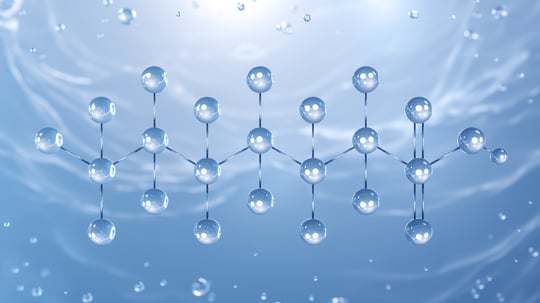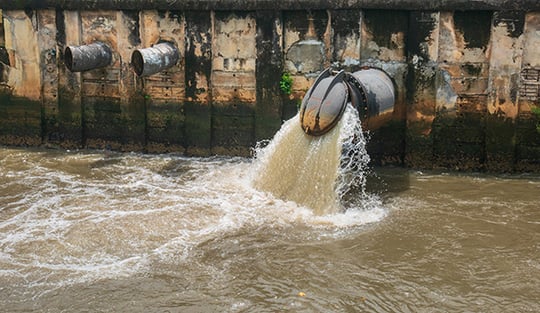Mike Deible, Ph.D. 15 min read
4 Factors Affecting the Potential for PFAS to Leach from Products into the Environment
Contributors
Mike Deible, Ph.D.
Subscribe to our newsletter
Introduction
The challenge posed by present and anticipated PFAS regulations on producers and users of these compounds is not only to determine their existence in product s, but also to evaluate whether it leaches or migrates into soil and water, creating potential exposure to animals and humans. The complexities of the problem demand more than a routine lab analysis; multi-disciplinary scientific understanding of the variety of factors that affect the leaching, degradation, and migration of PFAS compounds in a wide range of conditions is necessary.
Several states have already enacted legislation to reduce or eliminate PFAS, and the EPA has released nationwide guidelines that limit PFAS to extraordinarily low levels. Manufacturers need to know if and how PFAS could migrate or leach into the groundwater so that they can take preventative measures. The potential for PFAS to leach into the environment is influenced by several factors, making it a complex and multifaceted issue. To understand your level of risk, let's take a look at four key factors affecting how PFAS moves into the environment.
1. Chemical structure of PFAS

PFAS are a large group of synthetic chemicals, each with different structures and properties. The length of the carbon chain and the presence of functional groups (like carboxylic or sulfonic acids) can affect their solubility and mobility, thus influencing their leaching and transport behavior.
Furthermore, the chemical structure of PFAS can also impact their persistence in the environment. Some PFAS compounds, such as perfluorooctanoic acid (PFOA) and perfluorooctane sulfonate (PFOS), are highly stable and resistant to degradation. This resistance to breakdown contributes to their long-term presence in the environment and their potential to accumulate in organisms.
Other PFAS compounds – known as pre-cursors – have a variety of break down pathways in the environment with different intermediate steps or end points. None of these pre-cursors are currently covered by existing EPA drinking water regulations, but there is a significant push by some to include compounds with the potential to decompose or degrade into one of the PFAS compounds of concern. Adding to the complexity is the fact that carbon chain length is also important, as PFAS compounds with shorter carbon chains may exhibit lower persistence and have different leaching behaviors.
Knowing exactly which compounds may be present on equipment, packaging, raw materials, and more will help to determine the steps you need to take for release prevention and remediation.
2. Environmental conditions

Factors such as pH, temperature, and other chemicals in the environment can impact the leaching behavior of PFAS. For instance, in acidic or basic conditions, PFAS may become more mobile, leading to increased leaching.
The pH of the soil or water can influence the ionization of PFAS compounds, affecting their solubility and subsequent leaching. In acidic conditions, PFAS compounds may undergo protonation, a process in which they gain a proton, resulting in an increase in the positive charge of the PFAS molecules, leading to enhanced solubility and mobility. Solubility refers to the ability of a substance to dissolve in a particular solvent, and in this context, the increased solubility implies that PFAS compounds are more likely to dissolve and disperse in acidic environments.
Conversely, in alkaline conditions, PFAS compounds may experience deprotonation, a process in which they lose a proton. Deprotonation can result in a decrease in the positive charge of the PFAS molecules, leading to reduced solubility and a lower potential for leaching. Solubility is decreased in alkaline environments, making PFAS compounds less likely to dissolve and spread.
Protonation and deprotonation play a significant role in determining the chemical properties of PFAS compounds under different environmental conditions. The pH level of the surroundings influences these protonation and deprotonation reactions, thereby impacting the behavior and fate of PFAS in various ecosystems.
An experienced scientific consultant can assist you with an in-depth investigation of your facilities to understand the environmental conditions that would influence PFAS leaching into the soil and water so that you can take steps to mitigate the risk.
3. Soil and sediment characteristics

PFAS can enter the soil in several ways, including direct disposal into a landfill, water runoff from contaminated sites, and atmospheric deposition via emissions from industrial facilities. Once in the soil, PFAS can persist for extended periods due to their resistance to degradation. The type of soil or sediment where PFAS are present plays a significant role. Properties like organic carbon content, clay minerals, and the presence of other contaminants can affect the adsorption and leaching of PFAS.
Soils with higher organic carbon content generally have greater adsorption capacities for PFAS compounds. Organic matter acts as a sorbent, binding PFAS to its surface. Similarly, with their high surface area and cation-exchange capacity, clay minerals can strongly adsorb PFAS. Soils with high absorption rates limit the mobility of PFAS, reducing their potential to leach into surrounding groundwater.
However, if the soil or sediment is already contaminated with other substances, such as heavy metals or organic pollutants, competition for sorption sites may occur, potentially reducing the adsorption capacity for PFAS. Contaminated soils may increase the potential for PFAS to leach into groundwater.
Determining if PFAS is present in soil, and the likelihood of it leaching into groundwater, is complicated because of the numerous materials that could be present in a sample. Working with a lab that has experience with minerals and scientific investigation can help make an accurate determination of exactly what your soil contains.
4. Water Movement

The proximity and movement of water greatly influences the leaching of PFAS released through emissions, spills, or runoff. If released directly to the ground, PFAS may dissolve in groundwater and flow to water supply wells, contaminating drinking water sources. Rainfall or other forms of precipitation can cause surface water runoff, potentially carrying PFAS from the spill site to nearby surface water bodies. PFAS can also be transported within sediment, entering rivers, streams, lakes, or other waterways.
The geology of the rocks and soil that contaminated water encounters also affect leaching. Preferential flow pathways, such as fractures in rocks or macropores in soil, can enhance the movement of PFAS into groundwater. Porous materials with higher hydraulic conductivity will allow more transfer of PFAS. The presence of natural barriers such as wetlands, and man-made barriers such as flood and erosion control measures, will affect the rate and volume of flow.
Understanding the characteristics of soil and geological formations is an important part of controlling the fate and transport of PFAS.
Conclusion
Partnering with an experienced, multi-disciplinary testing and analysis lab will help you to understand the many factors unique to your situation that affect how PFAS can leach into the environment so that you can implement best practices for handling, disposal, incident response, and environmental monitoring.
RJ Lee Group brings decades of experience in scientific investigation to our clients, and we remain poised to help you overcome the challenges of preventing and remediating PFAS contamination.
Learn More
To help you assess your situation and identify potential PFAS sources that could leach into the environment, download this blog and our handy refence guide.
Ready to get started?
Share this blog

